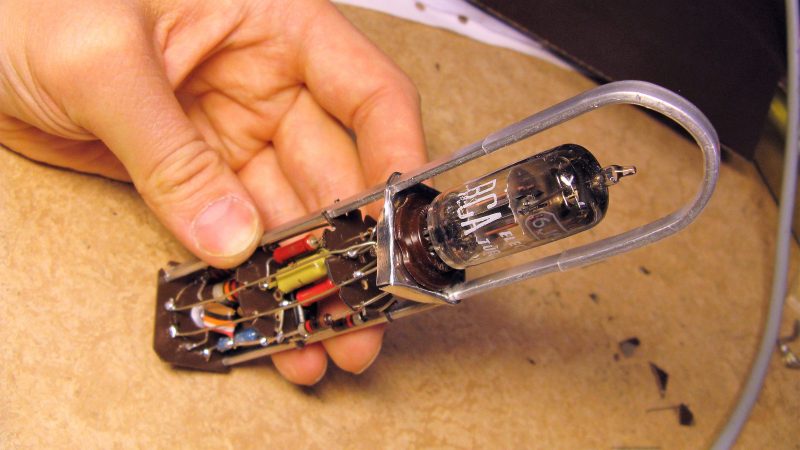As useful as computers are, most of them have all the design charm of a rubber doorstop. Oh, for the heady early days of computing, when vacuum tubes ruled, hardware was assembled by hand, and engineers always wore a tie.
Looking to recreate an elegant bit of computing hardware from that more civilized age, [updatebjarni] built a reproduction of a 1948 IBM TR-2 flip-flop module — 1,250 of which once formed the memory of the IBM Model 604 Calculating Punch. Admittedly more of a high-speed adding machine than a computer, the 604 is still an important piece of computing history, and [updatebjarni]’s scrap-bin reproduction of the field-replaceable module served as part of a computer history exhibit.
With a single 6J6 double triode tube nestled inside a bent aluminum frame, the goal was to reproduce the appearance of the original TR-2 module, and so the passive components wired up point-to-point style below the tube socket were chosen for their vintage look. That’s not to say the flip-flop won’t function. Although [updatebjarni] hasn’t tested it, he’s built other functional flip-flops from vintage components before, so this one should work too. Only 1,249 left to build and he’ll have enough for a working 604.
If you like this kind of build, you should probably check out some of our Vintage Computer Festival coverage. VCF East in April was a huge success, and VCF West is coming up in August in Mountain View. Hackaday will be well represented there, so stop by.
[via r/geekporn]
















Cool project. It makes you wonder how it all looked and felt (in real life) with 1250 of these circuits (and lot’s of other circuits) crammed in a box in a special room… humming and clicking during the time of operation so many years ago…
I wonder if the design of the WOPR was based on the IBM model 604 calculating punch?
Crammed into a series of racks rather than a box, the first computers were quite big. Se http://www.leo-computers.org.uk/leo1-photos.html.
Actually the idea that something as small as WOPR might be a supercomputer was relatively new in the early 1980’s, and down almost entirely to Seymour Cray. At that scale it was the speed of light which was a limiting factor in how fast computers could go, because their components were so large that if you used enough components to make a supercomputer the signals took longer to travel across the CPU than the transistors needed to switch. So Cray crammed his components together using advanced refrigeration techniques like freon running through channels in the circuit boards to keep them from overheating in their cramped quarters. When I saw WarGames I instantly pegged WOPR as a Cray-influenced design.
> Oh, for the heady early days of computing, when… engineers always wore a tie.
Some of us are trying to bring that back.
Excellent build quality. I love seeing great effort and craftsmanship go into something completely antiquated.
Hopefully not the ties. As for the tubes, there’s the heat, as well as power requirements. There’s a reason we left tubes behind.
Only use them in the winter and warm up the house.
Nah, white shirts and black ties. Just to make it easy and comfortable, clip-ons. The Agent Jones look.
Why would you want to bring mandatory ties (or any other mandatory dress code for everyone) back? What’s wrong with you?
Nice reproduction; I have one of the originals…
If you don’t want to build a full 604, you could start with a digital clock or some other simple state machine…
“from that more civilized age” of IBM supplying tabulating machines counting how mane Jews to burn this week in Nazi concentration camps. Good old IBM indeed.
I enjoyed the IBM 604 video. Looks like they used neon bulbs for indicators.
Finding 1250 6J6 tubes (plus spares) may be a problem, I only found one in the tube collection I am selling off.
[Here’s a hundred](http://www.ebay.com/itm/6J6-LOT-Qty-100-GE-RAYTHEON-SYLVANIA-RCA-ETC-ALL-TESTED-GOOD-/261925524610?hash=item3cfbfa5482:g:vOQAAOSwA3dYSXgX), [here’s another hundred](http://www.ebay.com/itm/100-pieces-NOS-NIB-GE-6J6-ECC91-6-15-6030-TS52-A4434-6CC31-USA-TUBE-/272183150733?hash=item3f5f61488d:g:5JgAAOSwdU1W8gDz&autorefresh=true), [and another 40](http://www.ebay.com/itm/Lot-of-40pcs-Dual-Triode-6N15P-ECC91-6J6-USSR-preamlifier-tube-/361998086775?hash=item5448c47277:g:b-EAAOSwrhBZMmpC), [and another 50](http://www.ebay.com/itm/50-pieces-NOS-NIB-GE-6J6-ECC91-6-15-6030-TS52-A4434-6CC31-USA-TUBES-/302255973827?hash=item465fdc25c3:g:5JgAAOSwdU1W8gDz&autorefresh=true). That’s from the first page of results on eBay. :)
OK, I guess that’s not the syntax for links on Hackaday… and no editing and no deleting. :/
Of course to be a proper 6J6 for computer use it needs to be a 1679, or its military equivalent the 6101.
IS there any schematic? I cant find schematic of device the topic is ABOUT.
Why always is the same?
Basic thing IS NOT present, but everything else is…
ciao
sorry
.
another worthless story
IF somebody really want for something to be clear
THEN schematic of the device will be first photo to start with…